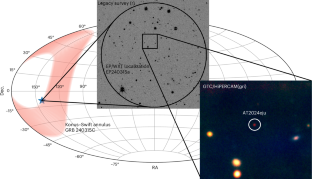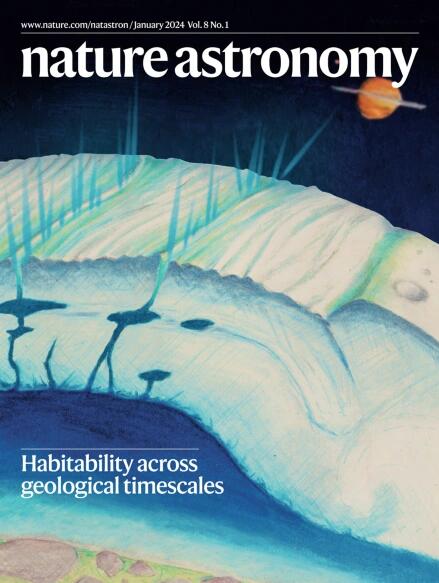Fast X-ray transient EP240315A from a Lyman-continuum-leaking galaxy at z ≈ 5
IF 14.3
1区 物理与天体物理
Q1 ASTRONOMY & ASTROPHYSICS
引用次数: 0
Abstract
The nature of the minute-to-hour-long fast X-ray transients localized by telescopes such as Chandra, Swift and XMM-Newton remains mysterious, with numerous models suggested for the events. Here we report multi-wavelength observations of EP240315a, a 1,600-s-long transient detected by the Einstein Probe, showing it to have a redshift of z = 4.859. We measure a low column density of neutral hydrogen and directly detect leaking ionizing Lyman continuum. The observed properties are consistent with EP240315a being a long-duration gamma-ray burst, and these observations suggest a possible interpretation in which a substantial fraction of the X-ray-transient population are lower-luminosity examples of similar events. If correct, then sensitive narrow-field searches could be a powerful complementary probe to traditional wide-field transient detection in the identification of samples of gamma-ray-burst-like events into the epoch of reionization. Observations of a fast X-ray transient reveal that it is a gamma-ray-burst explosion from a very distant galaxy that emits light with the wavelength necessary to drive cosmic reionization, the last major phase change in the history of the Universe.


来自z≈5莱曼连续泄漏星系的快速x射线瞬态EP240315A
钱德拉(Chandra)、雨燕(Swift)和xmm -牛顿(XMM-Newton)等望远镜观测到的一分钟到一小时的快速x射线瞬变现象的性质仍然很神秘,人们对这些事件提出了许多模型。在这里,我们报告了EP240315a的多波长观测,这是一个由爱因斯坦探测器探测到的1600秒长的瞬态,显示它的红移为z = 4.859。我们测量了中性氢的低柱密度和直接检测泄漏电离莱曼连续体。观测到的性质与EP240315a是一个长时间的伽马射线暴一致,这些观测结果提出了一种可能的解释,即相当一部分x射线瞬变种群是类似事件的低光度例子。如果正确的话,灵敏的窄场搜索可以作为传统宽场瞬态探测的有力补充,用于识别进入再电离时代的伽马射线暴样事件样本。
本文章由计算机程序翻译,如有差异,请以英文原文为准。
求助全文
约1分钟内获得全文
求助全文
来源期刊

Nature Astronomy
Physics and Astronomy-Astronomy and Astrophysics
CiteScore
19.50
自引率
2.80%
发文量
252
期刊介绍:
Nature Astronomy, the oldest science, has played a significant role in the history of Nature. Throughout the years, pioneering discoveries such as the first quasar, exoplanet, and understanding of spiral nebulae have been reported in the journal. With the introduction of Nature Astronomy, the field now receives expanded coverage, welcoming research in astronomy, astrophysics, and planetary science. The primary objective is to encourage closer collaboration among researchers in these related areas.
Similar to other journals under the Nature brand, Nature Astronomy boasts a devoted team of professional editors, ensuring fairness and rigorous peer-review processes. The journal maintains high standards in copy-editing and production, ensuring timely publication and editorial independence.
In addition to original research, Nature Astronomy publishes a wide range of content, including Comments, Reviews, News and Views, Features, and Correspondence. This diverse collection covers various disciplines within astronomy and includes contributions from a diverse range of voices.
 求助内容:
求助内容: 应助结果提醒方式:
应助结果提醒方式:


